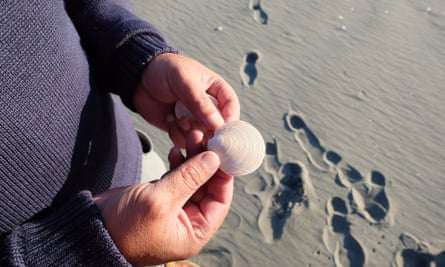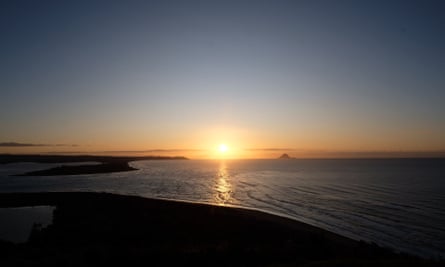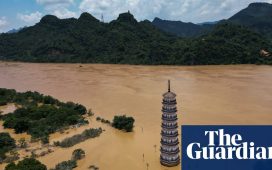Danny Paruru crouches at the water’s edge, letting it wash over his hand. Behind him, at the far hill-line, the sharp peaks mark out where the lands of his tribe, Te Whakatōhea, once stretched to before they were forcibly taken by the crown. In front of him the surface of the estuary ripples.
“Years ago our kaumatua [elders] were realising that we were deemed to be landless people – that we didn’t have a lot of land left, after the lands were confiscated. So they turned their eyes to the ocean,” he says. “Places around this area provided our sustenance and our survival, over many generations of our people.”
Now, that ocean, too, is changing. On this shoreline, the tribe still digs for pipi, a native clam, wading waist deep and reaching fingers into the soft muddy sand to find them. But other food sources, like cockles and mussels, have been shrinking or disappearing. The estuaries and mudflats are shifting, reshaped by new currents, rising sea levels and the runoff of farms.
Even the scent of the pipi beds is changing. “That smell isn’t there any more, that I remember as a child,” Paruru says – it’s hard to describe, but something of the dark, rich, briny smell of mud has disappeared, replaced by a lighter, sandier wash of salt.
As the climate heats waters around New Zealand, Māori tribes are recording changes – subtle and dramatic – to their lands and oceans, with some experiencing the losses of food-gathering practices that have sustained their communities for hundreds of years. As the speed and severity of changes ramps up, tribes are racing to find solutions to preserve the ocean environments that they depend on, and carry treasured species into the future.
‘The whales aren’t coming’
New Zealand has borne a series of record-breaking marine heatwaves over the past five years, with extreme changes in water temperature pushing up the mean temperature in some regions by more than four degrees over the past 12 months. The higher temperatures have redistributed ocean species: sending warm-water fish increasingly far south, changing the travel patterns of whales and, in some cases, contributed to mass die-offs including of sea sponges, shellfish, penguins, salmon and other fish species.
Accompanying the rise in temperature is increasing ocean acidification from carbon dioxide levels in the water, which eats away at shellfish, leading to smaller, less healthy creatures. Te Whakatōhea’s ancestral lands lie in the Bay of Plenty region, where the ocean recently remained in heatwave conditions for over a year.
“Every Māori community around the country that still maintains a relationship with the moana [ocean] would notice the changes,” says Mere Takoko, the Aotearoa country leader for Conservation International.
“In the south, Kaikoura, they’re going through months now where the whales aren’t coming. That has never happened before … That’s a signal of what’s happening in our oceans.”

Fish stocks drop
At the slow-running bends of the Arahura River, generations of Ngāi Tahu fishers have carried their nets out, wading into the still-chilly spring waters. They come for the whitebait, or īnanga: tiny native fish that travel up the river to spawn. Once caught with the weave of cloth and sugar sacks, they are now captured by fine-woven nets, fried whole in fritters, and considered a delicacy in New Zealand.
“My dad talked about when he was a child, it was so plentiful that they were putting it back into the river, they were just catching bucketloads” says Lisa Tumahai, Kaiwhakahaere [chairperson] of Te Rūnanga o Ngāi Tahu. “My husband talks about when he grew up in the village as a child, so they were putting it on the garden as manure, it was just so plentiful. If I go back about 15 years ago, I had cousins who, within the fishing season, would catch enough fish to sustain them.”
“That no longer exists,” she says. Ngāi Tahu still fish for whitebait, but the numbers have been sinking dramatically, hurt by overfishing, sediment buildup, runoff from farming, increased drought and now, changing temperatures. According to Climate change vulnerability assessments conducted by Niwa – New Zealand’s national climate researcher – whitebait are among the most vulnerable species to the effects of the climate crisis.
“We’re still a very active hunter and gatherer tribe,” Tumahai says. “If you can’t harvest māhinga kai, you can’t sustain yourself. You can’t bring food to the table.”
For Māori, mahinga kai, or the gathering of traditional foods, is regarded as a crucial cultural practice as well as a practical and economic one – integral to the process of welcoming visitors to marae, and to maintaining connections to the environment, ancestors and traditional knowledge systems.
“Kai [food] is a central part of life, our wellbeing, everything,” Paruru says. “So it’s our responsibility then to make sure that we protect what we have left for the future generations.”
‘We didn’t create this problem’
In the small fishing village of Moeraki, on the east coast of the south island, Ngāi Tahu hapū [subtribes] are watching the weather patterns change, and the coastlines begin to crumble.
“We used to go fishing when an easterly was forecast, knowing the velocity of the wind would slowly build up along the coast over the course of the day,” says David Higgins, an Upoko [leader] of Te Rūnanga o Moeraki. “Now it seems to happen in an hour, with the wind so much more volatile than it was in the past. It’s too dangerous to go out fishing when strong winds are forecast.”
In his own lifetime, Higgins says he has seen the food system changing rapidly. The tuna [native eels] can taste salt encroaching on the intertidal zones, and are now migrating out to sea earlier than they once did. The kina [sea urchins] are smaller and less plentiful.
“Many who live away from our village would be shocked by the changes to the coastline or how our traditional mahinga kai practices have had to adapt due to climate change,” he says.
Ngāi Tahu has an expansive corporate arm of the tribe, involved in fisheries, tourism, farming and transport. Now, the tribe has launched a sprawling plan to push its corporate activity to net zero carbon emissions: replacing its jet boat fleet with electric, changing its long-haul trucks to hydrogen, and launching regenerative agriculture pilots on its farms.
“We have a whakatauki, a proverb that gives direction for all of our decision making, and that’s mō tātou, ā, mō kā uri, ā muri ake nei: our decisions are for the generation today, the generation tomorrow and those out into the future not yet born yet,” Tumahai says.
“We, as Indigenous peoples from the small nations that we come from, we didn’t create this mess. We didn’t create this problem – but we will be disproportionately impacted by it.”

For Whakatōhea, a central focus for now is kuku – the green-lipped mussel that the iwi considers a taonga [cultural treasure]. Around the country, the mussels have proven highly vulnerable to heatwaves: locked on to the rocks, they are unable to shift when water or sunlight gets too hot to survive. In 2020, hundreds of thousands of mussels cooked to death on New Zealand beach in a heatwave.
The changes brought by climate breakdown “have that risk of reducing our connection to our mussels by not being able to go out and have it readily”, says Dr Kimberley Maxwell, a Whakatōhea scientist with the Moana Project, a series of studies funded by the New Zealand government that examine sea temperature changes and their effects.
With mussels near-annihilated on the rocks around the harbour, the tribe has over the last decade invested heavily in an off-shore mussel farm – there, the deeper waters are less subject to temperature leaps. Over time, the tribe hopes to keep expanding it into thousands of hectares of open ocean.
The mussels also play a crucial environmental role, says Maxwell: they filter the water and their shells help sequester carbon. “It’s really important that we try to maintain those connections, because they’re part of our identity,” she says.

Conservation International’s Takoko says Māori ties with the seas are “part of the cultural fabric.”
“Indigenous peoples enjoyed a very strong affinity with the beautiful oceans – we whakapapa [hold genealogical links], we consider ourselves relatives of these taonga species,” she says.
“A lot of our cultural knowledge is contained around these species – so in losing these taonga, we actually lose part of our culture.”













